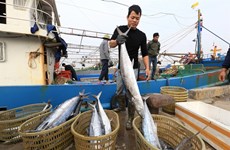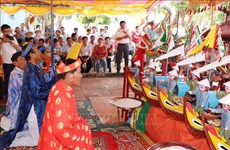Nguyen-era documents back sea claims
The Nguyen dynasty (1802-1945) worked hard to protect the nation,
producing many documents that confirm Vietnam's sovereignty over the
Hoang Sa (Paracel) and Truong Sa (Spratly) and archipelagoes. Today
these can be found in Hue, the former royal capital.
The Nguyen dynasty (1802-1945) worked hard to protect the nation,
producing many documents that confirm Vietnam's sovereignty over the
Hoang Sa (Paracel) and Truong Sa (Spratly) and archipelagoes. Today
these can be found in Hue, the former royal capital.
Researchers say the founder of the Nguyen dynasty, Emperor Gia Long (1762-1820), saw the sea as integral to the existence of the nation.
The spirit was later preserved and upheld by his descendants, especially his son, Emperor Minh Mang. During his reign from 1820-1840, Minh Mang conducted many works related to the sea and the protection of sovereignty over the Hoang Sa Archipelago. Researchers have found 14 reports on the work prepared by mandarins.
"The sea border area of the nation includes the Hoang Sa Archipelago, a place of great importance," one royal document said. The king deployed a surveying team to draw an accurate map of the islands and surrounding waters. This work was done in six years, from 1834-1839. Every year, he sent a team to inspect the sea zone.
At the same time, the king ordered the team to mark the border using wooden and stone markers and implemented a policy to support marine surveillance teams and penalise those who neglected these tasks.
In 1835, the king had nine tripod urns carved out of bronze, each representing a king. They were placed in front of the The Mieu temple inside the Imperial City.
The Mieu is a temple devoted to worshipping the kings from that dynasty. On the outside of the urns, researchers found many carved patterns, some of them denoting the East Sea and the Hoang Sa and Truong Sa archipelagoes and others showing warships, surveillance ships and o (black) ships, which could travel at higher speeds and were used for coastal protection.
Phan Thuan An, a dedicated researcher of Hue's royal culture, said the sovereignty of Vietnam over the East Sea and the archipelagoes was depicted clearly on the urns. The middle urn, which represents Emperor Gia Long, features East Sea carvings and other urns depict the seas and ships.
Going through the dynasty's 143 years of rule under 13 kings, there were 200,000 documentary sheets issued by 11 kings to address sea and islands affairs, 19 of which refer clearly to the administration of Vietnam on the Hoang Sa and Truong Sa islands as well as activities to protect marine and islands sovereignty. The documents also refer to fishing activities by Vietnamese fishermen on the seas around the achipelagoes.
Others included stories about assistance given to Western trading ships by royal Vietnamese soldiers. The last king of the dynasty, Bao Dai, continued issuing royal decrees, official letters and other documents stating sovereignty over the archipelagoes in 1939.
These documents can be found in remote villages in the localities as well. The communal house of My Loi village in the southeast district of Phu Loc in Hue has some. According to Nguyen Hao, 82, head of the village council, the house stores Han-Nom (Sino-Vietnamese) documents issued by the Nguyen dynasty. The house, which was built in 1808, has experienced three restorations, but the documents are in good condition.
Researchers have worked with the village council to interpret some of the documents, which were transcribed as ordered by the royal government to unite resources in the village with adjacent ones to assist the marine troops in protecting the archipelagos. The village participated in rescues of royal surveillance ships troubled at sea, supplying human resources and food to the troupes.
Phan Nhu Y, chief of Vinh My commune, which includes the village, said the village was working with related agencies in Hue to hand these documents to the Ministry of Foreign Affairs as proof of Vietnam's sovereignty over the achipelagoes.
Researcher Ho Tan Phan said that there were many documents in Hue that showed proof of Vietnam's sovereignty over the seas and islands, and that they were stored by village authorities as well as researchers and residents.
"We need a prestigious agency to collect them all and categorise them into functional topics," he said. "Those should be examined for legal value domestically and internationally in order to be strong evidence of national sovereignty." According to Phan, it was also necessary to examine documents related to the islands being stored in France, Japan, and even China in order to show that China's claims of sovereignty over the sea and islands of Vietnam were false.-VNA
Researchers say the founder of the Nguyen dynasty, Emperor Gia Long (1762-1820), saw the sea as integral to the existence of the nation.
The spirit was later preserved and upheld by his descendants, especially his son, Emperor Minh Mang. During his reign from 1820-1840, Minh Mang conducted many works related to the sea and the protection of sovereignty over the Hoang Sa Archipelago. Researchers have found 14 reports on the work prepared by mandarins.
"The sea border area of the nation includes the Hoang Sa Archipelago, a place of great importance," one royal document said. The king deployed a surveying team to draw an accurate map of the islands and surrounding waters. This work was done in six years, from 1834-1839. Every year, he sent a team to inspect the sea zone.
At the same time, the king ordered the team to mark the border using wooden and stone markers and implemented a policy to support marine surveillance teams and penalise those who neglected these tasks.
In 1835, the king had nine tripod urns carved out of bronze, each representing a king. They were placed in front of the The Mieu temple inside the Imperial City.
The Mieu is a temple devoted to worshipping the kings from that dynasty. On the outside of the urns, researchers found many carved patterns, some of them denoting the East Sea and the Hoang Sa and Truong Sa archipelagoes and others showing warships, surveillance ships and o (black) ships, which could travel at higher speeds and were used for coastal protection.
Phan Thuan An, a dedicated researcher of Hue's royal culture, said the sovereignty of Vietnam over the East Sea and the archipelagoes was depicted clearly on the urns. The middle urn, which represents Emperor Gia Long, features East Sea carvings and other urns depict the seas and ships.
Going through the dynasty's 143 years of rule under 13 kings, there were 200,000 documentary sheets issued by 11 kings to address sea and islands affairs, 19 of which refer clearly to the administration of Vietnam on the Hoang Sa and Truong Sa islands as well as activities to protect marine and islands sovereignty. The documents also refer to fishing activities by Vietnamese fishermen on the seas around the achipelagoes.
Others included stories about assistance given to Western trading ships by royal Vietnamese soldiers. The last king of the dynasty, Bao Dai, continued issuing royal decrees, official letters and other documents stating sovereignty over the archipelagoes in 1939.
These documents can be found in remote villages in the localities as well. The communal house of My Loi village in the southeast district of Phu Loc in Hue has some. According to Nguyen Hao, 82, head of the village council, the house stores Han-Nom (Sino-Vietnamese) documents issued by the Nguyen dynasty. The house, which was built in 1808, has experienced three restorations, but the documents are in good condition.
Researchers have worked with the village council to interpret some of the documents, which were transcribed as ordered by the royal government to unite resources in the village with adjacent ones to assist the marine troops in protecting the archipelagos. The village participated in rescues of royal surveillance ships troubled at sea, supplying human resources and food to the troupes.
Phan Nhu Y, chief of Vinh My commune, which includes the village, said the village was working with related agencies in Hue to hand these documents to the Ministry of Foreign Affairs as proof of Vietnam's sovereignty over the achipelagoes.
Researcher Ho Tan Phan said that there were many documents in Hue that showed proof of Vietnam's sovereignty over the seas and islands, and that they were stored by village authorities as well as researchers and residents.
"We need a prestigious agency to collect them all and categorise them into functional topics," he said. "Those should be examined for legal value domestically and internationally in order to be strong evidence of national sovereignty." According to Phan, it was also necessary to examine documents related to the islands being stored in France, Japan, and even China in order to show that China's claims of sovereignty over the sea and islands of Vietnam were false.-VNA











